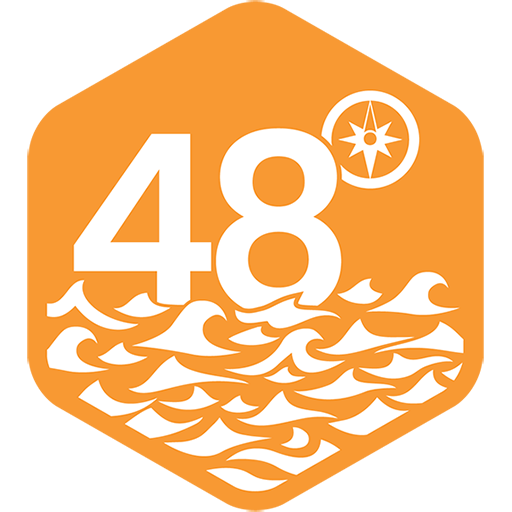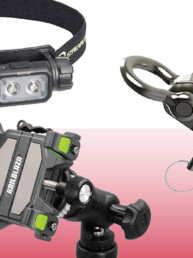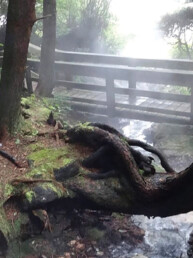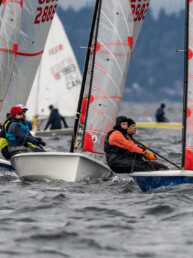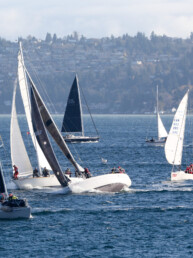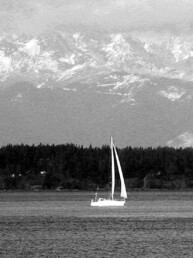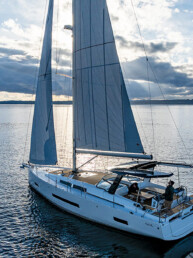There are as many ways to go cruising as there are boats, destinations, and people interested in waterborne travel. No one thing, no approach or region, no dynamic or itinerary, no ethos or adventure will suit everyone. On the other hand, our 48° North Cruising Rally was the best. Here it is, folks: the best four-day cruising itinerary in the San Juan and Gulf islands. Sorry, all other routes!
I kid, but here’s where I’m serious—I’m not sure how we’d improve what we did this year. Our group of boats was on the smaller side, but was full of the most wonderful and fun people with varied skills and experience, generosity, and ingenuity to share with the rest of us. Perhaps it was because this group of rally-goers was so capable and easy-going that I was able to more fully lean into the actual cruise we enjoyed.
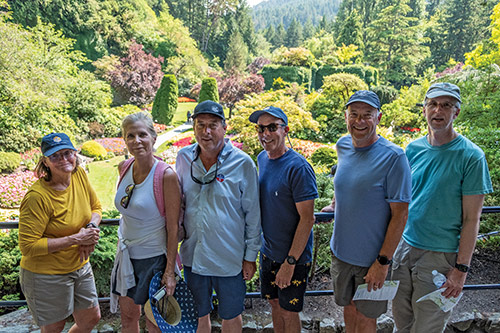
A few rally principles have been consistent since our first rally back in 2018. Among them is our ongoing partnership with Ullman Sails, and specifically loft owner Chuck Skewes. Well known to many in the 48° North community—with all of his knowledge, positivity, enthusiasm, and good humor—who wouldn’t want to go sailing with Chuck? Another standard has been the rally’s homeport of Anacortes, an equally good gathering location as it is a jumping-off spot.
So it was that in late July, we were meeting-and-greeting around a seaside table near Cap Sante Marina. The next morning, we set off from Anacortes under power in conditions we expected to be light most or all of the day—electing for the path east of Guemes to avoid the worst of the ebb in Rosario. We were headed for what I consider to be the most ambitious destination the 48° North Rally has set its sights on to date: Patos Island’s Active Cove.
We were pleasantly surprised to see the wind building a bit as we passed Lummi Island. We threw up the main and unfurled the Code Zero and relished some unexpected sailing until it dwindled again between Clark and Matia islands. On we motored, our course set for Patos.
Though familiar to some, I know few other cruisers who have spent a night at Patos. I have sailed as close to the island as I dared on sailboat races like Round the County, but hardly even noticed the cove south of the lighthouse—racer’s tunnel vision. Of course, there it is, and any cruising guide or navigation app confirms the same. I actually like it when cruising recommendations differ, but this one seemed pretty unanimous. Patos Island’s Active Cove, one of the embarrassment of riches that are the Washington Marine State Parks, will provide a challenging overnight stay for most boats. But those who pull it off will be handsomely rewarded.
As you might guess, the biggest difficulty is getting to the northernmost San Juan island and finding space to stay when you do. Enter one of our perennial rally participants, Ed, whose infectious enthusiasm has been a feature of our now 15-year friendship. Ed’s a longtime sailor, but in the past couple of years moved on from his Tartan 3400 in favor of something without sails that blends power, elegance, and capability—a Tiara Coronet 3100, Wildergal. Cruising friends, whatever your ride, I can highly recommend buddy boating or group-cruising with someone who has a fast powerboat and some team spirit! Last year, I begged Ed for a tow and, in 2025, I was sheepishly inquiring if he’d be willing to buzz up to assess the space situation at Patos before the sailboat fleet got past Sucia (our Plan B, and a nice one at that!).
Ed happily charged ahead, and soon reported back via text and VHF. There were two boats presently in Active Cove. Aw shucks. But both were leaving. Woop! Ed snagged the lone mooring buoy in the cove… we had a shot at this afterall. Put the hammer down! We did the fastest 6.5 knots we could muster, and turned the corner into one of the more idyllic surroundings you can find in our local cruising grounds. Patos was all ours!
The largest boat on the 2025 Rally, Callisti—a steel Waterline 50 cutter as stout as it is luxurious—captained by vastly experienced international cruisers Michael and Jean got in just ahead, and we arrived soon thereafter on CS 40 Black Bird, which we are fortunate to use each year as our Rally HQ vessel. We scanned the area for a good stern-tie set-up.
On the north side of the cove, remnants of an old dock are the foreground feature against a picturesque scalloped limestone backdrop. The dock pilings were old pitted concrete, covered in barnacles exposed at low tide. We found a ring in the rock that made a good stern-tie choice.
In such a small and narrow anchorage, we dropped the hook well toward the south shore in just under 20 feet, reversing toward that ring, and got a nice easy set. The season’s first stern-tie adventure wasn’t exactly slick, but it wasn’t eventful either. We were made, and motioned Callisti in next, they dropped their hook and backed down west of us, finding another ring in the rock. The C&C 30, Sea Boots, followed, tying on the east side of Black Bird as the smallest boat in the fleet.
We were just taking a breath and settling in when our attention was soon drawn to an ever-tightening stern line—the raft was shifting west in the building current. We’d read this might be a possibility, and the stern-tie setup was indeed getting more complicated.
At Active Cove’s southeast corner, there’s what looks (on charts) like a little piece of land connecting the main island and Little Patos Island that forms the south shore of the cove. It may dry at the lowest tides, but with our now flooding tide level, it was a river for east-west running current.
As the cross current built, the raft continued its westward push, bringing our stern line tautly against the barnacle-covered concrete piling. Because of our anchor orientation, if that line went, we’d be headed for the rocks. What ensued was a solid hour of puzzle solving, adding an extra anchor and stern line, swapping stern line positions, rebalancing between all of our contact points. Eventually, we were comfortably settled but the degree of difficulty for a stern-tie raft in Active Cove is quite high.
One pleasant feature of our trip was the happenstance of being in a part of the mixed-diurnal tide cycle when the smaller tidal exchange was at night. Thus, the current force waned through the evening and would not increase substantially until morning. Phew!
Once the anchoring effort was resolved, we were able to fully drink-in our surroundings and… just, wow. We dinghied ashore in the early evening to visit the Patos Light and hike the island. Million dollar views in every direction. Other than a handful of kayak campers, we had the entire island paradise to ourselves.
We returned to the boats and soon there was salmon on the grill as the sunset exploded into electric orange. Patos Island is officially my new favorite sunset spot in the San Juan Islands.
After a quiet night, we broke up the raft and headed for Bedwell Harbour where we’d clear into Canada. It was a dead flat motor with water mirroring the distant hills in mirage fashion. Our only excitement was being boarded by the Shiprider Program, a collaboration between US and Canadian law enforcement—an experience that was both friendly and efficient.
With our courtesy flag now hoisted, there was still no breeze, so we powered on toward Russell Island, just outside of Saltspring Island’s Fulford Harbor.
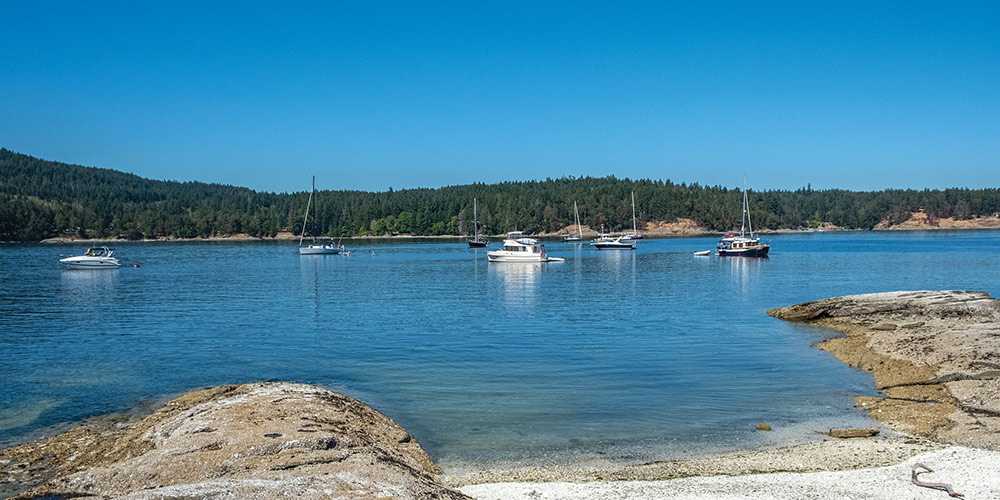
Approaching from the east, we rounded the north side of the island and perhaps a dozen anchored boats soon came into view. We were eager to drop the hook and head to shore to check out the BC Marine Park we’d read a lot about, with its thousand-year-old clam gardens that were nurtured by First Nations and its historic homestead and orchard settled by a Hawaiian family.
Reports and guides suggested that the holding at Russell Island was… meh. And we can now confirm as much, with two attempts dragging into oblivion on a rocky shelf before we finally caught with some confidence. We were relieved to see our fellow rally-goers set with less struggle. Once anchored, in spite of the evening’s tsunami advisory following the Kamchatka earthquake (see page 6 for a little more about that), all rally boats stayed put without issue. The ferry wake through the anchorage is less present than I worried it might be, I hardly noticed it honestly.
Soon, we zipped to the dinghy dock and were happily strolling another stunningly beautiful island park. Enticing beach nooks, picturesque cairns, clam gardens, and more stunning views through gnarled madrona and a few oak trees provided an outstanding walk. Some summertime visitors are lucky enough to have descendents of the homesteading Hawaiian family on the island to share history, but since they weren’t there, we gladly explored on our own. It was too early for most of the orchard’s fruit—visitors are allowed to harvest a limited amount—but we found a couple of ripe blackberries nearby.
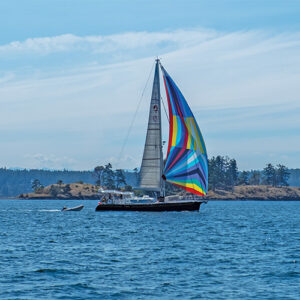
After an indulgent steak dinner potluck aboard Callisti, we settled in for a calm night on the water, but rest came late and in fits with the possibility of tsunami activity. The morning brought hazy relief, and we were up and out early.
Our near-dawn start was predicated on the notion that we were headed to an anchorage that can be crowded, Tod Inlet. We set off in glassy waters, but heading south into Saanich Inlet found a little breeze to play in. Sails went up but, soon enough, it was dissipating and we motored slowly through Brentwood Bay’s eclectic blend of craft ranging from grand to seemingly derelict.
We nosed into Tod Inlet, which was well populated by other boats, but definitely not packed. Working toward the head of the bay near the dinghy dock and trail to the main entrance to Butchart Gardens, a pair of stern-tied boats on the southwest shore each were pulling anchor. Huzzah! We happily snagged their spot, and got settled with a four-boat stern-tie raft with no complications. The holding was stellar, the stern-tie options numerous, and the wind and water were accommodatingly calm.
Though there were many other boats in Tod, I think the stern-tie option has a lot of appeal. In the busy anchorage, we really felt like we were in our own world, and weren’t very aware of our neighbors. Some harbors are like that, others lend themselves to more interaction. If it got breezier, however, swinging would be far preferable, because any wind is likely to be on the beam if you’re stern-tied.
Before long, our rally crew made the short trip into the dock, where a 10-minute walk brought us to the front gate of the expansive and exquisite Butchart Gardens. Tickets aren’t cheap (about $40 CAD), but every member of our group thought it was well worth it, regardless of their inherent levels of garden enthusiasm. The gardens are simply stunning, not a leaf out of place; every plant perfectly healthy, and obvious care is given to the tiniest details. Amazingly, there’s not a gardener to be seen. How?!
Perhaps the Butchart visit’s most notable discovery was that tickets are good for the full day and there was an Australian blues outfit playing in the bandshell that evening. We headed back to the boats where the afternoon heat soon drew every participant into the warm-ish water for some swimming and paddling. If you’ve visited Tod Inlet, you may recall that the waters are dotted with millions of tiny moon jellyfish. After a dip in the inlet, the assurance that they wouldn’t sting was confirmed, but they made for a unique element of the swim—you really can’t swim here without touching at least a few moon jellies.
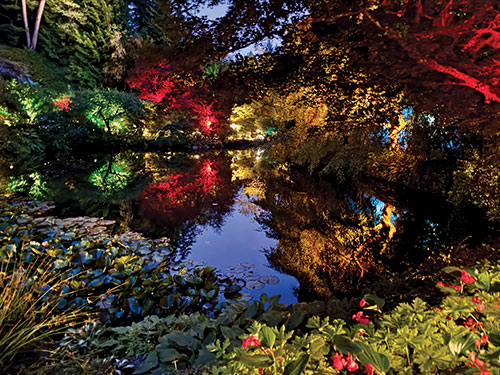
A casual happy hour and dinner on the raft followed, after which we headed back for some blues. The three-piece band was impressively skilled, the lead singer spun a heck of a between-tune yarn, and the setting was simply one-of-a-kind.
The surprise delight of the evening, however, was finding the gardens artfully illuminated as the concert broke up in the fading light. Our tickets were still good for a couple hours until the gardens closed at 11 p.m. We wound up walking the entire garden again, experiencing it anew in the lighted nighttime version, and it was essentially a private tour—with only a handful of other concert goers walking the grounds. We walked and dinghied back well into the dark of night, fulfilled and astonished by the incredible variety the day had provided. You just never know what you might get up to while cruising.
We didn’t break up the raft at Tod Inlet until midday, and it was already beginning to feel like the end of summer camp. We had one more night, but we knew this rally was coming to its conclusion, and it felt too soon!
We steamed back the way we came, once again coming into sailable breeze in Saanich Inlet, this time building as we went north. We had a splendid close reach to Moses Point where we began beating our way east. The breeze was coy for a while before pummeling us with 25 knots on the nose as we got into the San Juans.
We took a close route along the south shore of Spieden Island, where we were able to catch a glimpse of several dozen of the island’s animal inhabitants. We cleared back into the states with a no-drama video call via the app, and headed toward Jones Island’s North Cove as quickly as we could manage.
We got settled in time for one last group dinner, scrounging what was left in our respective fridges, ice boxes, and pantries. The islands gave us the parting gift of a colorfully pastel sunset, and we laid our heads down early, wiped from a couple late nights and a windy transit.
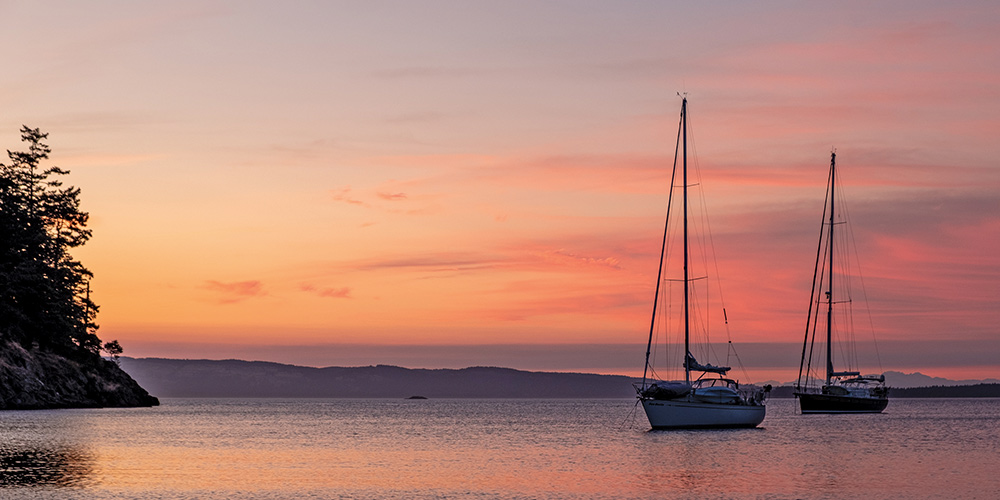
The morning dawned sunny yet again—we were batting a thousand on this trip. We headed ashore at Jones for what might be my favorite hike in the San Juans. It’s familiar, but just so appealing. A hint of autumn was in the air as we crunched through the season’s first fallen leaves. Glistening vistas, a pristine island park, boaty possibilities in every direction. How can you not love this stuff?
Before clamboring into our dinghies, we said our goodbyes, sharing gratitude for this wonderful group of friends, and enduring amazement for just how blissful this rally had been.
For my cruising taste, this itinerary is as good as it gets for a four-night local cruise. We stayed at three uninhabited island parks, and our only stop with shoreside “amenities” provided something absolutely unique with layers of charm. If we were ever to do a rally two or three times as long, I’d still like the three-to-one ratio of quiet natural destinations peppered every so often by some enticing shoreside activity.
I’ll plant my flag in this route as one to contend with any, but as I think of it, there are dozens of options. How lucky are we to spend time on the water in this special corner of the world? And to do so with friends who so happily share the journey, their knowledge, and themselves… it doesn’t get any better.
Join us next year, and learn more at 48north.com/cruising-rally
Joe Cline lives with his wife Kaylin and two children in Edmonds, WA. He has been the Managing Editor of 48° North since 2014.
Joe Cline
Joe Cline has been the Managing Editor of 48° North since 2014. From his career to his volunteer leadership in the marine industry, from racing sailboats large and small to his discovery of Pacific Northwest cruising —Joe is as sail-smitten as they come. Joe and his wife, Kaylin, have welcomed a couple of beautiful kiddos in the last few years, and he is enjoying fatherhood while still finding time to make a little music and even occasionally go sailing.
